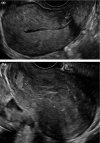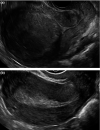Sonographic findings in acute puerperal endometritis
- PMID: 34760528
- PMCID: PMC8409861
- DOI: 10.1002/ajum.12112
Sonographic findings in acute puerperal endometritis
Abstract
Purpose: To evaluate the reliability of the sonographic subserosal hypoechoic rim sign and endomyometrial junction indistinctness in distinguishing patients with acute puerperal endometritis from other common postpartum complications, particularly those with retained products of conception.
Methods: Radiographic coding identified all patients presenting to Auckland City Hospital over a 12-month period between 1 March 2016 and 28 February 2017 who had pelvic ultrasound scans to assess for postpartum complications. Clinical notes were reviewed to identify those patients with a clinical diagnosis of acute endometritis. After exclusion criteria were applied, the ultrasound images of 31 patients with acute endometritis and 31 randomly selected controls from the remaining pool of postpartum patients were randomised and anonymised. Ultrasound images were retrospectively reviewed by two independent radiologists to identify the presence or absence of the hypoechoic subserosal rim and endomyometrial junction indistinctness signs.
Results: The average sensitivity and specificity for readers identifying the subserosal hypoechoic rim sign in full-term postpartum patients with acute endometritis were 76.9% and 92.1%, respectively. Interobserver reliability was moderate with a kappa value of 0.5. The average sensitivity and specificity for endomyometrial junction indistinctness were 89.0% and 95.2%, respectively, with substantial inter-observer agreement, Kappa 0.7. These signs remained specific but were less frequently observed in postpartum patients scanned during early pregnancy.
Conclusion: We have shown that identifying the subserosal hypoechoic rim and endomyometrial junction indistinctness on ultrasound scans can reliably help to distinguish patients with acute postpartum endometritis from other complications, particularly in full-term postpartum patients.
Keywords: endometritis; endomyometritis; hypoechoic rim; junctional indistinctness; puerperal; retained products of conception; ultrasound.
© 2018 Australasian Society for Ultrasound in Medicine.
Figures


References
-
- Chen K, Berghella V, Barss V. Postpartum Endometritis. UpToDate, 2017. Accessed March 2018.
-
- World Health Organisation (WHO) . Recommendations for Prevention and Treatment of Maternal Peripartum Infections; 2015. Retrieved from http://apps.who.int/iris/bitstream/10665/186171/1/9789241549363_eng.pdf. Accessed March 2018. - PubMed
-
- Sinha P, Otify M. Genital tract sepsis: early diagnosis, management and prevention. Obstetrician Gynaecol 2012;14(2):106–14.
-
- Plunk M, Lee JH, Kani K, Dighe M. Imaging of postpartum complications: a multimodality review. AJR 2013;200:W143–54. - PubMed
LinkOut - more resources
Full Text Sources
